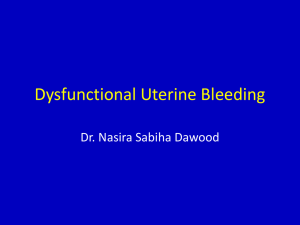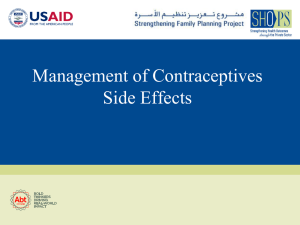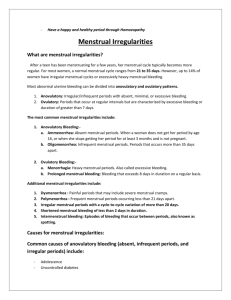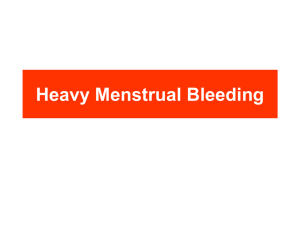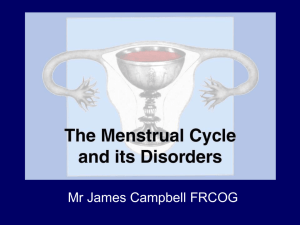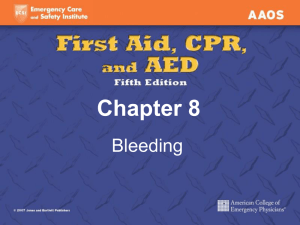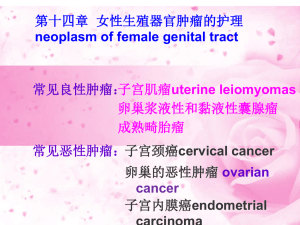Menstrual disorders - North West Gynaecology
advertisement
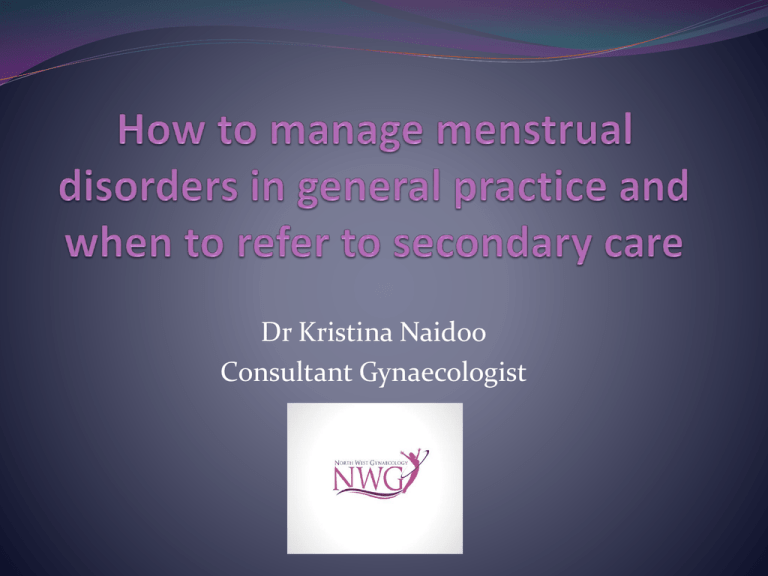
Dr Kristina Naidoo Consultant Gynaecologist Menstrual Disorders Defining normality Defining problem Investigations Treatment Normal menstruation Most menstrual cycles 22 to 35 days Normal menstrual flow 3 to 7 days Most blood loss occurs within first 3 days Menstrual flow amounts to 35ml* In general, most normal menstruating women use five or six pads or tampons per day. Menarche/Menopause Menarche average age 12.9 Anovulatory cycles 80% in first year, 10% in 6th year Menopause 42-58 (average 51) Postmenopausal bleeding > 1 year after the last menses Symptoms of AUB Heavy menstrual bleeding Intermenstrual bleeding (IMB) Postcoital bleeding (PCB) Irregular menstrual cycle Postmenopausal bleeding +/-pain FIGO classification of Causes of AUB (non-pregnancy) PALM-COEIN P A L M C O E I N polyps adenomyosis leiomyoma malignancy & hyperplasia coagulopathy ovulatory disorders endometrial causes iatrogenic not classified When to refer Suspected cancer- symptoms PCB lasting more than 4 weeks over 35 years IMB persistent and unexplained 1 or more episodes of PMB and NOT on HRT Persistent or unexplained PMB 6/52 after cessation of HRT Any unscheduled bleeding on Tamoxifen NOT Repeated, unexplained PCB When to refer Suspected cancer- signs Palpable abdominal/pelvic mass not obviously fibroids/urinary or GI Lesion on cervix suspicious of cancer Unexplained vulval lump Vulval bleeding due to ulceration Heavy Menstrual Bleeding (HMB) Excessive menstrual blood loss which interferes with a woman's physical, social, emotional and/or material quality of life It can occur alone or in combination with other symptoms HMB Blood loss is subjective 30% women consider their bleeding to be excessive Half of these have a normal blood loss (<80ml) Women aged 30-49, 1:20 consults GP re HMB each year HMB accounts for 12% of Gynae referrals £7 million a year spent on prescriptions in primary care (2007) Mirena LNG-IUS Provided long-term use (at least 12 months anticipated) Prevents endometrial proliferation. Contraceptive. Doesn't impact future fertility. Unwanted outcomes: irregular bleeding that can last for six months; amenorrhoea; progestogen-related problems such as breast tenderness, acne and headaches; uterine perforation at insertion (1 in 100,000 chance). As equally effective in improving quality of life and psychological well-being as hysterectomy. Submucous fibroid and Mirena IUS Tranexamic acid Oral antifibrinolytic . If no improvement, stop after three cycles. Unwanted outcomes: indigestion; diarrhoea; headache. No increased risk of thrombosis. Cochrane review. Dose: 500 mg tablets. 2 to 3 tablets (1-1.5g three to four times daily for three to four days. From onset of heavy bleeding. NSAIDs Commonly used: mefenamic acid Reduce production of prostaglandin. If no improvement, stop after three cycles. Preferred over tranexamic acid in dysmenorrhoea. Unwanted outcomes: indigestion; diarrhoea; worsening of asthma Dose: mefenamic acid 500 mg tablets. 1 tablet three times daily during heavy bleeding. COCPs Prevent proliferation of the endometrium. Also act as a contraceptive. Do not impact future fertility. Unwanted outcomes: mood change; headache; nausea; fluid retention; breast tenderness; DVT; MI; CVA. Oral progestogen Commonly used: Norethisterone Prevents proliferation of the endometrium. Does not impact future fertility. Dose: 15 mg daily on days 5-26 of the cycle. Unwanted outcomes: weight gain; bloating; breast tenderness; headaches; acne; depression. A recent Cochrane Review showed that this regime of progestogen results in a significant reduction in menstrual blood loss but that women find the treatment less acceptable than intrauterine levonorgestrel. Injected progestogen Depot-medroxyprogesterone acetate Prevents proliferation of the endometrium. Contraceptive. Does not impact on future fertility. Unwanted outcomes: as for oral progs; weight gain; irregular bleeding; amenorrhoea; bone density loss. Current guidance: Use in adolescents as last resort. Other women re-evaluate after 2 years, if significant risk factors for osteoporosis consider alternative. When to refer Suspicion from history of increased risk of pathology: E.g. family history of endometrial or colonic cancer Infertility/nulliparity Obesity/diabetes Unopposed oestrogen therapy PCOS ‘One stop’ Menstrual Dysfunction Clinic Conventional pathway ‘One stop’ pathway General Gynaecology Clinic ?biopsy ‘One stop’ menstrual dysfunction clinic Pelvic scan Review, list for Day Case Hysteroscopy Pre-operative assessment clinic Hysteroscopy under GA Follow-up to plan management Outpatient Hysteroscopy RCOG recommendation 2012 favourable tariff Diagnosis of benign intrauterine pathology Treatment Resection polyps, small fibroids, RPOCs IUD retrieval Conclusions Reassurance re normal patterns of bleeding Full blood count -first line investigation Low threshold for pelvic scanning (TVS) Hormonal contraception for HMB Red flag symptoms-> HSC205 pathway Risk factors for endometrial pathology-> refer early ‘One stop’ clinics advantageous

